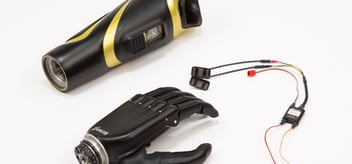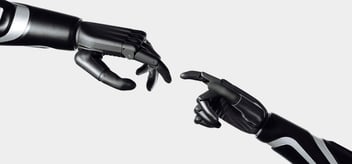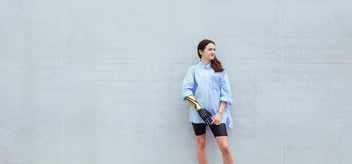Ideal Candidates for Bionic Arms
Bionic prosthetic arms consist of electrodes and sensor systems that pick up electrical signals from the patient’s residual limb muscles, process them, and then use them to control the bionic hand and associated prosthetic components. These electrodes are placed on the skin surface, inside the prosthetic socket. Following the fitment of the bionic prosthetic arm, the patient is trained on how to open and close the bionic hand, how to pick up objects, how to hold objects, and how to use different grips for different objects, among various other tasks. This process is known as controls training and it is a very vital aspect of any bionic prosthetic arm fitment.
Bionic prosthetic arms offer patients a wide range of advantages such as consistency in operation, increased range of movements and comfort, a smooth and natural function as well as effortless strength and good reflexes. Despite these advantages of bionic prosthetic arms, they are not always accepted by the patients and are not always suitable for use by all amputees. If patients have not been thoroughly assessed to ensure whether they exhibit the right characteristics for fitment of a bionic prosthetic arm, it can lead to rejection and failure of the prosthetic system. This may lead to further complications such as overuse of the opposite limb, leading to a whole set of different problems for the patient.
Therefore, it is essential to ensure that the patient conditions are ‘ideal’ for fitment as well as the use of the bionic prosthetic arm. The following text will discuss and mention some of the most important factors that must be considered before fitment to ensure optimal functioning of the prosthetic arm and reduce the risk of rejection –
The most important factors that make an individual an ideal candidate for fitment and use of bionic prosthetic bionic arms include the residual limb condition, the patient’s physical and emotional status as well as patient’s motivation to use the prosthetic arm.
1. Residual limb factors
An ‘ideal’ patient will have a well-healed residual limb devoid of any swelling or fluid concentration (edema) as well as no neuromas (pain at the cut nerve end). Some patients also experience phantom limb sensation and phantom limb pain whereby the patient feels pain in the amputated limb even though the limb is missing. Before the fitment of the bionic prosthetic arm, the prosthetist has to make sure that these sensations are not being exaggerated with the use of the prosthesis. To ensure optimum results, patients must be prescribed residual limb strengthening exercises which will allow the patient to bear the weight of the prosthetic arm, especially in the case of amputees with greater involvement of the limb.
Another characteristic that makes fitment favorable is the length of the residual limb. The residual limb must be of sufficient length to allow for easy placement and fitment of the electrodes and myosites, within the prosthetic socket. Simultaneously, the limb should be short enough to maintain the length and cosmesis of the prosthetic arm, making it suitable for use. The length of the residual limb affects the efficacy of the control of the bionic arm as well as the functional demands of the user.
Residual limbs with constant limb volume also affect the quality of movement of the bionic prosthetic arm since limb volume fluctuations interrupt the total contact between skin and electrodes. This skin to electrode contact is very essential to maintain the transmission of signals from the limb to the prosthesis.
Patients with scar tissue can be prescribed bionic arms, provided that the scar tissue is strong enough to bear the weight of the prosthesis as well as the pressure of the electrodes. It has been noted that the electrical signals can be obtained through scar tissue, therefore, the strength of the tissue is the determinant.
2. Patient’s physical condition
The user should be capable of supporting the weight of the bionic prosthetic arm. For patients of slight stature, a bionic prosthetic arm is often contraindicated as they are unable to bear the weight of the prosthetic system. Along with this, the patient must have the ability and tolerance to wear the prosthetic socket, as it has a very intimate fit and is worn without any sock. Ability to wear an intimately fitting socket without a prosthetic sock.
Patients control the prosthesis using their own muscles and nerves and thus, must have the ability and strength to do so. During the physical assessment, prior to fitment and prescription formulation, the prosthetist conducts a muscle strength test to determine if the muscles are strong enough for the generation of the electrical signals. These muscles are grade from 0-5 in tan increasing order. Bionic prosthetic arms are prescribed to those patients whose muscle strength is 3+ as their muscles will be able to produce electrical signals. Often, patients undergo physical therapy to stimulate their nerves and strengthen their muscles.
3. Psychological factors and motivation
Enthusiastic and motivated patients adapt more easily and are more likely to accept the prosthetic arm. Patients struggling with the reality of their condition need to be counseled to accept the situation. This will encourage them to more readily accept the prosthesis and will show better results with the bionic arm.
Patients of sound mind and cognition make excellent candidates as they are aware on how to use the arm and are less likely to perform activities that may cause harm to themselves and/or the prosthesis.
4. Miscellaneous factors that make a user ‘ideal’
- Ability to make the required visits for training and evaluation.
- Conscientious about maintaining current prosthesis.
- A patient who wants a solution that will give him/her greater function for everyday tasks
- The pattern of consistent wear, if the patient is an old user.
For users who currently have a body-powered prosthesis, but wish to transition to a bionic prosthetic arm, the following factors can be studied –
- Patients who want more grip force
- Patients who demand a greater range of motion and a larger ‘functional envelope’ (area of use)
- Patients who find their harness uncomfortable or restrictive
- Patients exhibiting symptoms of overuse or nerve entrapment syndrome in the intact arm due to harness
- Patients who want a more natural-looking prosthetic arm
- Patients who are looking for relief from backaches that occur due to postural deficit










